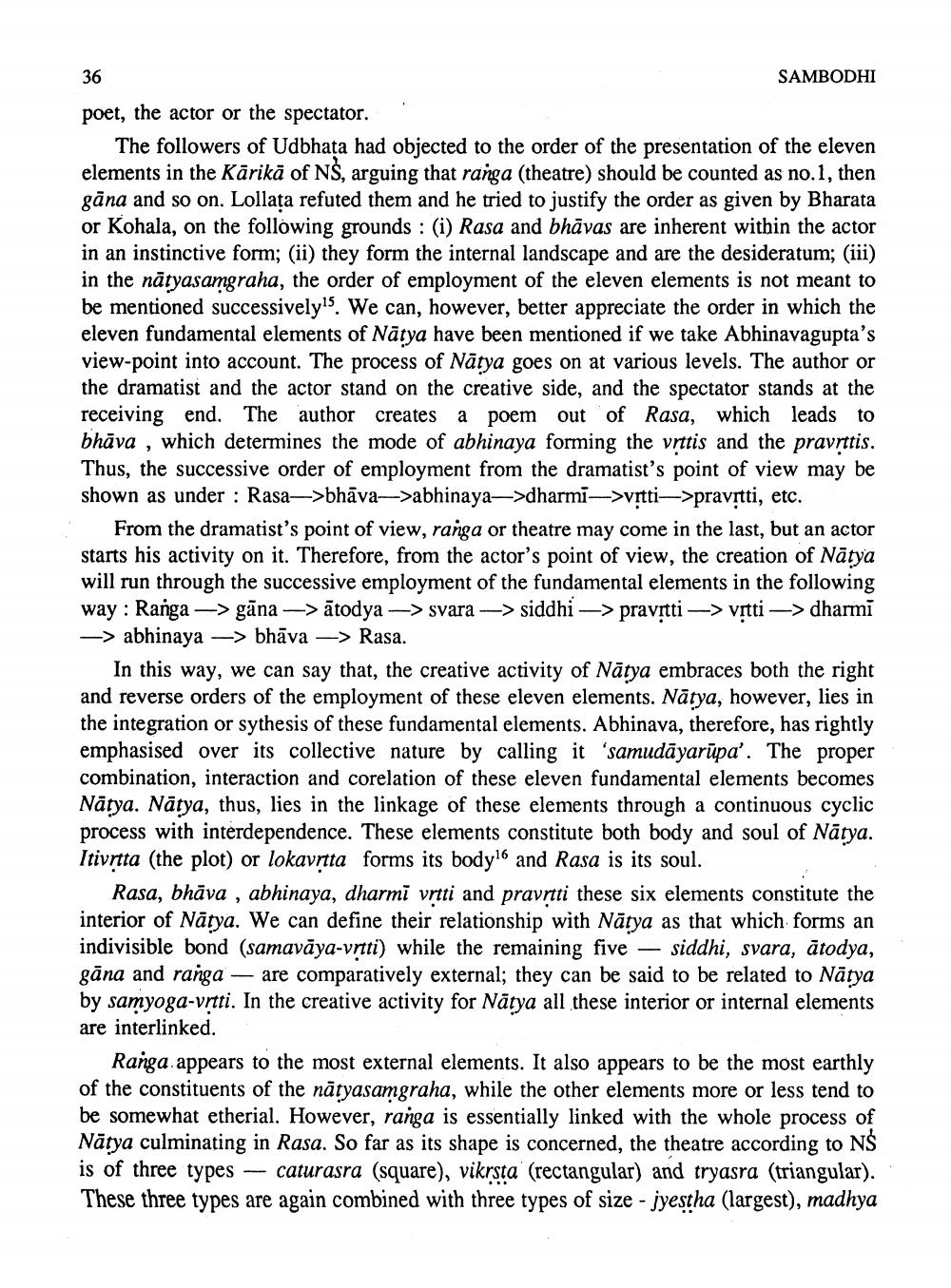________________
36
SAMBODHI
poet, the actor or the spectator.
The followers of Udbhata had objected to the order of the presentation of the eleven elements in the Kārikā of NS, arguing that ranga (theatre) should be counted as no.1, then gāna and so on. Lollața refuted them and he tried to justify the order as given by Bharata or Kohala, on the following grounds : (i) Rasa and bhāvas are inherent within the actor in an instinctive form; (ii) they form the internal landscape and are the desideratum; (iii) in the nātyasamgraha, the order of employment of the eleven elements is not meant to be mentioned successively's. We can, however, better appreciate the order in which the eleven fundamental elements of Nātya have been mentioned if we take Abhinavagupta's view-point into account. The process of Nātya goes on at various levels. The author or the dramatist and the actor stand on the creative side, and the spectator stands at the receiving end. The author creates a poem out of Rasa, which leads to bhāva , which determines the mode of abhinaya forming the vrttis and the pravrttis. Thus, the successive order of employment from the dramatist's point of view may be
shown as under : Rasa—>bhāva->abhinaya->dharmi->vrtti->pravrtti, etc. : From the dramatist's point of view, ranga or theatre may come in the last, but an actor
starts his activity on it. Therefore, from the actor's point of view, the creation of Nātya will run through the successive employment of the fundamental elements in the following way: Ranga-> gāna ->ātodya -> svara -> siddhi —> pravrtti -> vitti-> dharmi -> abhinaya -> bhāva -> Rasa.
In this way, we can say that, the creative activity of Nātya embraces both the right and reverse orders of the employment of these eleven elements. Nātya, however, lies in the integration or sythesis of these fundamental elements. Abhinava, therefore, has rightly emphasised over its collective nature by calling it 'samudāyarūpa'. The proper combination, interaction and corelation of these eleven fundamental elements becomes Nātya. Nātya, thus, lies in the linkage of these elements through a continuous cyclic process with interdependence. These elements constitute both body and soul of Nātya. Itivrtta (the plot) or lokavrtta forms its body and Rasa is its soul.
Rasa, bhāva , abhinaya, dharmī vrtti and pravrtti these six elements constitute the interior of Nātya. We can define their relationship with Nātya as that which forms an indivisible bond (samavāya-vrtti) while the remaining five — siddhi, svara, ātodya, gāna and ranga - are comparatively external; they can be said to be related to Nātya by samyoga-vrtti. In the creative activity for Nātya all these interior or internal elements are interlinked.
Ranga appears to the most external elements. It also appears to be the most earthly of the constituents of the nātyasamgraha, while the other elements more or less tend to be somewhat etherial. However, ranga is essentially linked with the whole process of Nātya culminating in Rasa. So far as its shape is concerned, the theatre according to NS is of three types - caturasra (square), vikrsta (rectangular) and tryasra (triangular). These three types are again combined with three types of size - jyestha (largest), madhya




